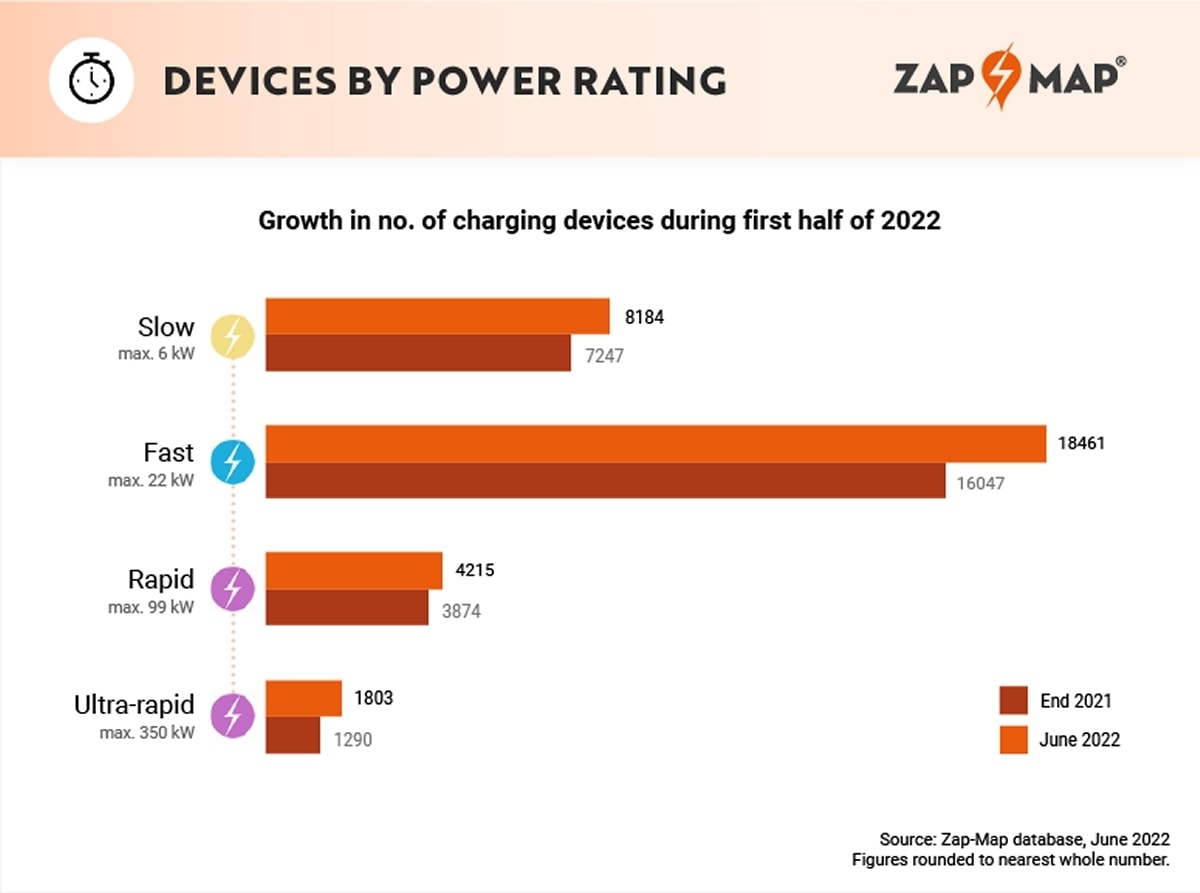Ultra-fast chargers lead growth in UK EV infrastructure as total tops 32,000

The numbers of ultra-fast electric vehicle chargers in the UK grew by 40% in the first half of 2022, according to data from EV charging app Zap-Map.
As of the end of June 2022, Zap-Map’s data shows that the number of ultra-rapid charge points, which cater to drivers travelling long journeys and looking to charge up as quickly as possible, has grown from 1,290 in December 2021 to 1,803.
Zap-Map says this shows that the ultra-rapid charging roll-out is more than keeping pace with the increase in EV drivers, which has grown 29% in the first half of 2022.
The growth in ultra-rapid charge points is largely due to networks such as MFG EV Power, InstaVolt and Gridserve Electric Highway, which are rolling out high-speed charging hubs of at least six devices across the country, mainly on motorways and trunk roads.
The total number of charging devices across the UK has grown by almost 15% since the end of December (from 28,458 to 32,663), though the bulk of charging devices (18,461) are what Zap-Map calls “fast” chargers – mainly 7-22kW devices suitable for overnight on-street charging in several hours.
Of the 4,205 new devices installed this year, 1,662 of them are on-street chargers, including “slow chargers” that are no faster than a typical domestic charger (6kW). The number of on-street chargers has increased by just under 19% in 2022 so far, growing from 8,842 at the end of 2021 to 10,504 at the end of June ’22.
A combination of networks, including char.gy and Connected Kerb, has been driving the growth of on-street chargers, though Ubitricity – which predominantly fits slow devices into lamp posts – has installed 981 chargers so far this year, the most of any network.
Moreover, of the 4,205 new devices installed in the first six months of 2022, almost half – 49% – were installed by just five networks. After Ubitricity, Pod Point has installed 649 devices of varying speeds. In third place, rapid charging network InstaVolt has installed 166 chargers, while Zap-Pay partner char.gy and destination charging provider VendElectric have installed 145 and 126 respectively.
While EV charging networks have been getting chargers up and running across the UK, the area that has seen the highest rate of growth so far this year is the north-east. Indeed, the number of charging devices in the North East has grown by 21% in the first six months of 2022, increasing from 897 at the end of 2021 to 1,085 in June.
Despite this, Greater London has seen the highest number of devices installed this year, increasing from 9,160 devices at the end of 2021 to 10,865 at the end of June – an increase of more than 18%. The East of England has also seen significant growth, with 1,775 devices in the ground at the end of 2021, and 2,097 by the end of June – an increase of 18%.
Melanie Shufflebotham, co-founder and COO of Zap-Map, said: “We know there are a variety of use cases for electric vehicle chargers, more so than with a petrol or diesel vehicle, so it’s really encouraging to see the UK’s charging infrastructure showing growth in a number of different areas.”
She added: “The 40% increase in the number of ultra-rapid chargers is clearly the headline figure so far in 2022. These types of chargers make longer journeys far easier, so the big increase should really mean we see an end to ‘range anxiety’.”
“But let’s not forget that slower chargers also have a critical role to play. They might not provide the excitement of adding hundreds of miles in minutes – but with more than half a million pure-electric cars now on UK roads, their part to play in the adoption of electric cars is just as important as their ultra-rapid counterparts.
Shufflebotham concluded: “It’s crucial that the roll-out of high-speed charging hubs continues at pace, alongside the increasing provision of on-street chargers for those without driveways, ideally with local councils engaged along the way.”


